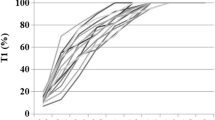Abstract
Purpose
The aim of this study was to compare TOF-Cuff™ (TOF-C) and TOF-Watch™ (TOF-W) data following rocuronium-induced neuromuscular block and its reversal with sugammadex.
Methods
Twenty elderly patients aged 68–82 years scheduled for surgery under general anesthesia were enrolled in this study. After induction of anesthesia, neuromuscular block resulting from administration of 0.6 mg/kg rocuronium was concurrently evaluated using TOF-C and TOF-W. The onset of neuromuscular block and duration until the first twitch response following post-tetanic count (PTC) and 2 Hz train-of-four (TOF) stimulation reappeared were evaluated. When the response to the TOF stimulus was detected with both monitors, additional doses of rocuronium were administered to maintain the neuromuscular block. After surgery, 2 mg/kg sugammadex was administered when 1–2 TOF twitches were observed with the TOF-W and the time required for facilitated recovery to a TOF ratio of > 0.9 was assessed.
Results
Regression analyses revealed no statistically significant differences in the mean [SD] onset of rocuronium-induced neuromuscular block [127.8 (27.2) s, 123.5 (30.5) s], time to recovery of the first PTC twitch [23.9 (8.0) min, 25.4 (8.6) min], time to recovery of the first twitch with TOF stimulation [37.2 (8.8) min, 38.9 (11.1) min] and time to adequate reversal with sugammadex [139.2 (30.6) s, 151.8 (31.5) s] between TOF-C and TOF-W, respectively. Bland–Altman analyses also showed acceptable ranges of the biases and limits of agreement between the two methods.
Conclusions
TOF-C may be clinically applicable for the evaluation of both the depth of neuromuscular block and restoration of neuromuscular function.


Similar content being viewed by others
References
Martini CH, Boon M, Bevers RF, Aarts LP, Dahan A. Evaluation of surgical conditions during laparoscopic surgery in patients with moderate vs deep neuromuscular block. Br J Anaesth. 2014;112:498–505.
Bruintjes MH, van Helden EV, Braat AE, Dahan A, Scheffer GJ, van Laarhoven CJ, Warlé MC. Deep neuromuscular block to optimize surgical space conditions during laparoscopic surgery: a systematic review and meta-analysis. Br J Anaesth. 2017;118:834–42.
Carron M. Respiratory benefits of deep neuromuscular block during laparoscopic surgery in a patient with end-stage lung disease. Br J Anaesth. 2015;114:158–9.
Kotake Y, Ochiai R, Suzuki T, Ogawa S, Takagi S, Ozaki M, Nakatsuka I, Takeda J. Reversal with sugammadex in the absence of monitoring did not preclude residual neuromuscular block. Anesth Analg. 2013;117:345–51.
Hemmerling TM, Le N. Brief review: Neuromuscular monitoring: an update for the clinician. Can J Anaesth. 2007;54:58–72.
Kopman AF. Measurement and monitoring of neuromuscular blockade. Curr Opin Anaesthesiol. 2002;15:415–20.
Claudius C, Viby-Mogensen J. Acceleromyography for use in scientific and clinical practice: a systematic review of the evidence Anesthesiology. 2008;108:1117–40.
Suzuki T, Mizutani H, Miyake E, Fukano N, Saeki S, Ogawa S. Infusion requirements and reversibility of rocuronium at the corrugator supercilii and adductor pollicis muscles. Acta Anaesthesiol Scand. 2009;53:1336–40.
Yamamoto S, Yamamoto Y, Kitajima O, Maeda T, Suzuki T. Reversal of neuromuscular block with sugammadex: a comparison of the corrugator supercilii and adductor pollicis muscles in a randomized dose-response study. Acta Anaesthesiol Scand. 2015;59:892–901.
Rodiera J, Serradell A, Álvarez-Gómez JA, Aliaga L. The cuff method: a pilot study of a new method of monitoring neuromuscular function. Acta Anaesthesiol Scand. 2005;49:1552–8.
Yoshida F, Suzuki T, Kashiwai A, Furuya T, Konishi J, Ogawa S. Correlation between cardiac output and reversibility of rocuronium-induced moderate neuromuscular block with sugammadex. Acta Anaesthesiol Scand. 2012;56:83–7.
Bland JM, Altman DG. Statistical methods for assessing agreement between two methods of clinical measurement. Lancet. 1986;1(8476):307–10.
Johnson MA, Polgar J, Weightman D, Appleton D. Data on the distribution of fibre types in thirty-six human muscles. An autopsy study. J Neurol Sci. 1973;18:111–29.
Sterz R, Pagala M, Peper K. Postjunctional characteristics of the endplates in mammalian fast and slow muscles. Pflügers Arch. 1983;398:48–54.
Ibebunjo C, Srikant CB, Donati F. Morphological correlates of the differential responses of muscles to vecuronium. Br J Anaesth. 1999;83:284–91.
Suzuki T, Fukano N, Kitajima O, Saeki S, Ogawa S. Normalization of acceleromyographic train-of-four ratio by baseline value for detecting residual neuromuscular block. Br J Anaesth. 2006;96:44–7.
Kopman AF, Kopman DJ. An analysis of the TOF-watch algorithm for modifying the displayed train-of-four ratio. Acta Anaesthesiol Scand. 2006;50:1313–4.
Arain SR, Kern S, Ficke DJ, Ebert TJ. Variability of duration of action of neuromuscular blocking drugs in elderly patients. Acta Anaesthesiol Scand. 2005;49:312–5.
Furuya T, Suzuki T, Kashiwai A, Konishi J, Aono M, Hirose N, Kato J, Ogawa S. The effects of age on maintenance of intense neuromuscular block with rocuronium. Acta Anaesthesiol Scand. 2012;56:236–9.
Suzuki T, Kitajima O, Ueda K, Kondo Y, Kato J, Ogawa S. Reversibility of rocuronium-induced profound neuromuscular block with sugammadex in younger and older patients. Br J Anaesth. 2011;106:823–6.
Shiraishi N, Aono M, Kameyama Y, Yamamoto M, Kitajima O, Suzuki T. Effects of cardiac output on the onset of rocuronium-induced neuromuscular block in elderly patients. J Anesth. 2018;32:547–50.
Kopman A, Lawson D. Milliamperage requirements for supramaximal stimulation of the ulnar nerve with surface electrodes. Anesthesiology. 1984;61:83–5.
Acknowledgements
Financial support: departmental funding.
Author information
Authors and Affiliations
Corresponding author
Ethics declarations
Conflict of interest
Shunichi Takagi and Takahiro Suzuki have received speaker fees from MSD Inc., Japan.
About this article
Cite this article
Kameyama, Y., Takagi, S., Seto, K. et al. Efficiency of the TOF-Cuff™ for the evaluation of rocuronium-induced neuromuscular block and its reversal with sugammadex: a comparative study vs. acceleromyography. J Anesth 33, 80–84 (2019). https://doi.org/10.1007/s00540-018-2587-4
Received:
Accepted:
Published:
Issue Date:
DOI: https://doi.org/10.1007/s00540-018-2587-4




